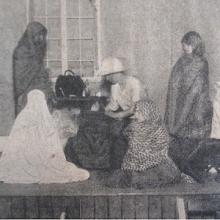Culture

Video: March of Flags from 1929 Boy Scout World Jamboree
This video shows the opening ceremony at the Boy Scouts’ third World Jamboree, held in England in 1929. The jamboree was known as the “Coming of Age” Jamboree, since it marked twenty-one years since the foundation of the Boy Scouts.

Photograph of the Boy Scout World Jamboree in 1929
This photograph shows the South African contingent at the Boy Scouts’ third World Jamboree, held in England in 1929. The jamboree was known as the “Coming of Age” Jamboree, since it marked twenty-one years since the foundation of the Boy Scouts.

Photograph of “Indian Tableaux at Endon”
This photograph, which was originally published in the G.F.S. Magazine in September 1923, is from a tableau performed by members of the Girls’ Friendly Society (GFS), which was a youth organization akin to the more popular Girl Guides.

Long Teaching Module: Exploring Empire through the Lens of Childhood and Gender
As European empires expanded at the end of the end of the nineteenth century, imperialism came to permeate everyday life and had a pervasive influence on childhood, shaping everything from education to sports and literature.

Calendar from Cham manuscript, early 20th century
An image of the Cham calendar from an early 20th century Cham manuscript. The column on the left and top row indicate measurements of months of the calendar drawn from the Islamic lunar calendar. Numerals written in Cham script in the middle are symbolic of the Cham Hindu solar calendar.
Ariya Cam Bini
Ariya Cam Bini is one of the few ariya that has little to no historical references in the poem. It is possible to deduce from the language of the poem and from the study of extant versions of the manuscript that its origins likely lie in the 19th century.
Short Teaching Module: Ariya Cam Bini, a 19th century Cham Poem
Ariya Cam Bini is a 19th–century epic poem written in the Austronesian Cham language of mainland Southeast Asia. The poem comes from the area called Pāṇḍuraṅga or Nâgar Cam, a pluralistic society in terms of culture, religion, and identity.
Maya Drinking Vessel with Seated Lord, 7th-8th century
This large ceramic vessel, made for drinking chocolate, shows a figure wearing a loincloth, necklace, and a large headdress that looks like the tail feathers of the quetzal bird.

Maya Vase with Mythological Scene, 7th-8th century
This drinking cup shows the aging Rain God Chank with a ceremonial ax in one hand and the other on a building that has split open.

Maya Monument with glyphs, 4th-9th centuries
This stone monument carved with glyphs comes from Tortuguero, a Maya archeological site in southernmost Tabasco, Mexico that has been badly damaged by development. The monument is in a museum in Tabasco, and the smaller fragment is in the Metropolitan Museum in New York City.